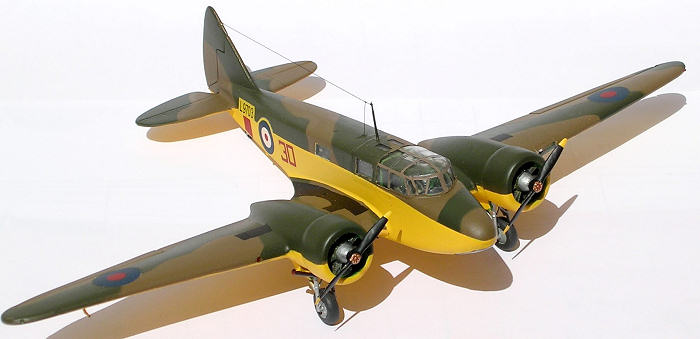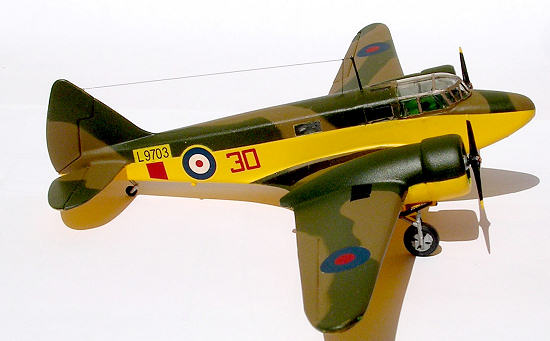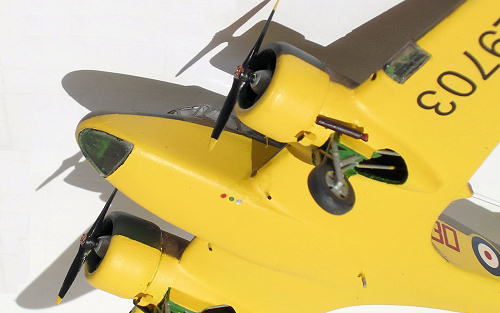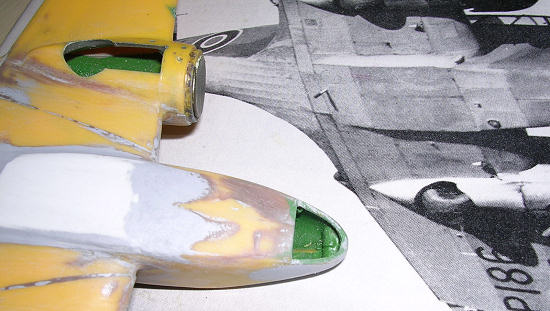
Frog 1/72 Airspeed Oxford
| KIT: | Frog 1/72 Airspeed Oxford |
| KIT #: | ? |
| PRICE: | ? |
| DECALS: | ? |
| REVIEWER: | Carmel J. Attard |
| NOTES: |

| HISTORY |
The Oxford is a military
development of the 1934 Airspeed Envoy feeder liner. It was the first twin-engined
monoplane advance trainer to enter RAF service. It first went into service in
January 1939 and at the outbreak of war there were nearly 400 of the type in
service.
The Oxford was a low wing monoplane of full wooden structure with a semi monocoque fuselage, linen covered control surfaces and hydraulically retracted undercarriage. The aircraft was powered by the Armstrong–Siddeley Cheetah IX radial engine with the Fairey Reed 2-bladed metal propellers. Later, the Oxford Mk 1s and with three crew members were powered by Cheetah X engine and wooden propellers. An Armstrong Whitworth gun turret was mounted on the fuselage. This had a 7.69 mm Lewis machine gun and a bombsight in a glazed nose. These were used as trainers for bomb aimers and gunners. The Oxford Mk2 version had double controls and carried no gun turret and were used to train pilots, navigators and wireless operators.
The Oxford was also built by the De-Havilland Aircraft Company Ltd; Percival Aircraft Ltd; and the Standard Motor Co. Ltd. It served primarily as an aircrew trainer, others in communications anti aircraft co-operation duties whereas those in the Middle East were used as ambulances. As aircrew trainer it served with Australia, Canada, New Zealand and Southern Rhodesia besides in the UK. The various marks differed very little externally. The variety concerned internal equipment and in power plant. The Oxford Mk V was another type that was powered by two-455HP Pratt & Whitney Wasp Junior and was mainly used in Rhodesia and Canada. The Oxford was also used as a light transport and on communication duties. The Oxford Mk 2 had a span of 53’4”, length of 34’6” and a maximum speed of 188 MPH.
| KITS |
The Oxford Frog kit
The kit
has long disappeared out of circulation and certainly not an easy kit to obtain
these days. Mine was bought from a model
 shop in Valletta for the meager price
of 3s 6d, a far cry from prices of kits nowadays. The kit comes with an exotic
artwork on the box of two Oxfords crossing the sky, a sky empty of civilian
airliners in those days. On the box back cover was a three view colour drawing,
which faded to the extent that the camouflage looked stone and dark earth
whereas the instructions states dark earth and green for the same aircraft and
markings.
shop in Valletta for the meager price
of 3s 6d, a far cry from prices of kits nowadays. The kit comes with an exotic
artwork on the box of two Oxfords crossing the sky, a sky empty of civilian
airliners in those days. On the box back cover was a three view colour drawing,
which faded to the extent that the camouflage looked stone and dark earth
whereas the instructions states dark earth and green for the same aircraft and
markings.
The kit is injection moulded in bright yellow plastic, 39 parts in all and 7 clear parts for cockpit and front Perspex and side windows. There is hardly any panel lines engraving being a plywood covered aircraft. There is a simple decal sheet along with a double-sided instruction sheet showing an exploded view of the whole model. Incidentally I won’t be using the decal sheet in case there is any interested collector who needs it for free. The parts were numbered on the instruction sheet but not on the parts or sprues themselves. A circular Perspex display stand comes with the kit and the kit cat No is 3361/P. Originally the kit was issued by International Model Aircraft Ltd of Mordon Road, Morton, London SW 19. Some years later the kit was released by Roves Scale Models Ltd of Margate, Kent, UK.
| CONSTRUCTION |
 Assembling the kit went together reasonably well once the parts were cleaned up
of flash. Interesting to note that the parts are labeled with the colour they
should be in full wording as opposed to the numbers that the kits are labeled on
kits of today. Again the kit shows its age as the joint between the fuselage
side fairings and wings needed putty to rid the gap that cannot be overlooked.
The cockpit floorboard, item 4, should be turned 180 degrees to fit correctly in
place and seats positions adjusted to the new location. The shape of cockpit is
not quite convincing and the minor adjustment needed will not make it match the
fuselage shape and therefore is best left in original shape rather than replaced
with some other remoulded one. Some patience was needed to mask and paint the
intricate framework of the cockpit canopy. Also the fuselage roof is not quite
the correct shape as in the Frog kit it is rather flat as compared to the smooth
elliptical cross section on the real aircraft.
Assembling the kit went together reasonably well once the parts were cleaned up
of flash. Interesting to note that the parts are labeled with the colour they
should be in full wording as opposed to the numbers that the kits are labeled on
kits of today. Again the kit shows its age as the joint between the fuselage
side fairings and wings needed putty to rid the gap that cannot be overlooked.
The cockpit floorboard, item 4, should be turned 180 degrees to fit correctly in
place and seats positions adjusted to the new location. The shape of cockpit is
not quite convincing and the minor adjustment needed will not make it match the
fuselage shape and therefore is best left in original shape rather than replaced
with some other remoulded one. Some patience was needed to mask and paint the
intricate framework of the cockpit canopy. Also the fuselage roof is not quite
the correct shape as in the Frog kit it is rather flat as compared to the smooth
elliptical cross section on the real aircraft.
The
interior consisted of two seats. However making reference to a cutaway drawing
that appeared in ‘The Aeroplane’ issue of 28th July 1937 as well as
reference to the new Pavla kit of the Oxford the interior detail is more than
the two-crew seats and two control columns. An instrument panel was added that
was painted as per Pavla kit parts. The cabin roof was extended with a staggered
piece at the rear using plastic card. Three 1mm, diameter holes were drilled
under the nose port side area where beacon lights are located. Making reference
to the front page of ‘Profile Publication’ issue No 227 where a clear picture
of an Oxford  banking to port exhibits to a good advantage a rectangular belly
construction that was lacking in the frog kit but was present on the Pavla
Model. This was rectified on the Frog kit by shaping a rectangular piece of
plastic card measuring 33x17x1mm this was tapered towards the rear in section
and fairing it with putty and rescribing new panel lines as well as adding a
central antenna in the middle and at the rear of the box shape construction.
(See photo). The Frog kit also had a somewhat too small and pointed nose shape
and again was rebuilt with putty on the sides and upper area. The ejector pin
marks were removed from the elevator surfaces by filing down the whole surface
of the parts until they disappear. At the same time this brings the rather thick
section of the elevator to the correct size in scale. Panel lines are then
carefully rescribed. The rears of the radial engine were also blanked with a
round piece of plastic card to avoid the see through effect of this compartment.
The engine cowling looked a little bit too short but was left unaltered. Roof
antenna was added using a thin steel pin.
banking to port exhibits to a good advantage a rectangular belly
construction that was lacking in the frog kit but was present on the Pavla
Model. This was rectified on the Frog kit by shaping a rectangular piece of
plastic card measuring 33x17x1mm this was tapered towards the rear in section
and fairing it with putty and rescribing new panel lines as well as adding a
central antenna in the middle and at the rear of the box shape construction.
(See photo). The Frog kit also had a somewhat too small and pointed nose shape
and again was rebuilt with putty on the sides and upper area. The ejector pin
marks were removed from the elevator surfaces by filing down the whole surface
of the parts until they disappear. At the same time this brings the rather thick
section of the elevator to the correct size in scale. Panel lines are then
carefully rescribed. The rears of the radial engine were also blanked with a
round piece of plastic card to avoid the see through effect of this compartment.
The engine cowling looked a little bit too short but was left unaltered. Roof
antenna was added using a thin steel pin.
| FINAL CONSTRUCTION |
 The areas that were to be in
trainer yellow were airbrushed with an undercoat of semi matt white and when dry
two coats in yellow were applied. This was carefully masked and the upper
surfaces airbrushed in dark earth and green camouflage. I have taken the liberty
of using the spare decals that came with the Pavla kit ao that the model
represents an Oxford Mk 1 L-9703 that served with the No3 Flying Training School
in South Chorney to train bomb aimers during the period of 1938-1939.
The areas that were to be in
trainer yellow were airbrushed with an undercoat of semi matt white and when dry
two coats in yellow were applied. This was carefully masked and the upper
surfaces airbrushed in dark earth and green camouflage. I have taken the liberty
of using the spare decals that came with the Pavla kit ao that the model
represents an Oxford Mk 1 L-9703 that served with the No3 Flying Training School
in South Chorney to train bomb aimers during the period of 1938-1939.
August 2006
| REFERENCES |
SAM Vol 15 No 9/10 ‘Inside Story’ and ‘Aircraft in Detail’
Aircraft Profile No 227
The Aeroplane July 28 1937.
Copyright ModelingMadness.com. All rights reserved. No reproduction in part or in whole without express permission from the editor.
If you would like your product reviewed fairly and fairly quickly, please contact the editor or see other details in the Note to Contributors.